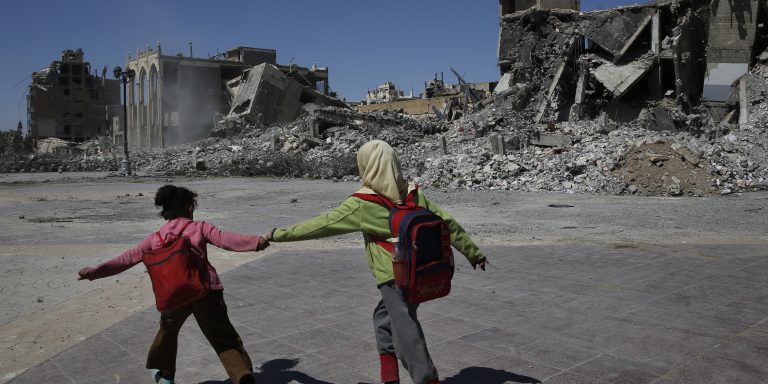INTELBRIEF
April 26, 2018
IntelBrief: Who Will Rebuild Syria?

- An April 19 report by the Washington Post highlights the challenges in rebuilding Raqqa, Syria.
- The U.S. airstrikes in support of the ground campaign helped topple the Islamic State but have left Raqqa decimated.
- It is impossible to overstate the scale of the challenge to supply basic services like electricity and water; health care and education present even bigger hurdles.
- The scale of destruction in Syria is matched in cities throughout Iraq and Yemen, as persistent conflict plagues the Middle East.
.
Raqqa is facing a desperate post-conflict scenario in the wake of the effort to degrade the so-called Islamic State in Syria.The regional and international coalitions active there could have helped locals start the process of social, political, and economic rebuilding. The willingness and capability of the international community to make positive change is diminishing, however, particularly with respect to the U.S., which has presented conflicting approaches for its role in Syria.
An extensively detailed April 19 report in the Washington Post focused on the enormous challenges in the initial efforts to make Raqqa livable once again. Raqqa was at one time the self-proclaimed capital of the Islamic State’s caliphate. The city, once home to 400,000 people, is now without electricity and running water. Over 11,000 buildings were destroyed or damaged in the campaign to liberate the city. There are reports of thousands of corpses still located in the rubble, as well as undetonated explosive ordinances everywhere. As detailed in the Washington Post report, the destruction of the effort to topple the Islamic State has generated resentment among the very people the campaign was intended to help: those who call Raqqa home. As the gap in time increases from Raqqa’s liberation to the start of Raqqa’s recovery, resentment of those living there will only increase. This resentment could bolster positive sentiment for the Islamic State.
In March 2018, the Trump administration announced it was holding off on funding reconstruction efforts in the areas of Syria where the U.S and its coalition forces toppled the Islamic State, Raqqa being the most prominent and costly. The suspension of approximately $200 million in aid, a drop in the bucket in terms of sheer need but still desperately important, is in some sense understandable; the situation on the ground is so chaotic and tenuous, reconstruction plans could be ineffective or even counterproductive. Yet it is hard to argue that there is an overwhelming need to provide assistance, and any efforts are better than none at all.
The estimates of what it would take to rebuild Syria are staggering. In 2017, the U.N. and World Bank estimated it would cost approximately $200 billion and would take a generation. That estimate is likely too low, especially as there is no end in sight for the war. President Trump has stated his intention for the U.S. to leave Syria and leave its rebuilding to countries in the region with a greater stake in what occurs and withrelatively more influence. It is unclear if a U.S. withdrawal will actually unfold, but leaving Syria to the hands of regional powers is a dangerous prospect. It is unlikely the countries currently using Syria to establish power and domination in the region will cooperate on a comprehensive effort to stabilize the country and prevent a further collapse.
.
For tailored research and analysis, please contact: info@thesoufancenter.org
[video width="960" height="540" mp4="https://thesoufancenter.org/wp-content/uploads/2018/04/Final-Edit-1-181.mp4" poster="https://thesoufancenter.org/wp-content/uploads/2018/04/AP_18097542963214.jpg"][/video]